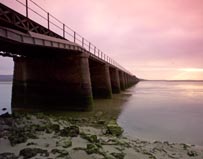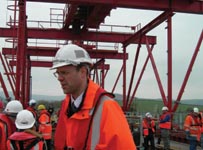Leven Viaduct on the Carnforth to Barrow line
09 May 2006
Apart from the scenic beauty of much of the Cumbrian coast railway, the Sellafield British Nuclear Fuels reprocessing plant uses the route for transporting materials in and out of its site. The railway also provides a passenger link to the south, Manchester, and Manchester Airport.
 Any local fears that Network Rail was contemplating its closure or reduction to a single line have now been fully dispelled. The London North Western territory has recently started work to remove speed restrictions and make the route’s structures good for decades to come. With an anticipated total cost of around £14 million, the biggest bridge scheme investment in the territory during the next five years has begun at Leven Viaduct.
Any local fears that Network Rail was contemplating its closure or reduction to a single line have now been fully dispelled. The London North Western territory has recently started work to remove speed restrictions and make the route’s structures good for decades to come. With an anticipated total cost of around £14 million, the biggest bridge scheme investment in the territory during the next five years has begun at Leven Viaduct.
Leven Viaduct carries the Carnforth to Barrow section of railway over the Leven river estuary in south Cumbria, on a 49-span structure built in 1857. A causeway was built along the alignment of the viaduct and used to construct the original viaduct. The remains of that causeway can still be seen today. The estuary is tidal. The viaduct was widened to accommodate twin tracks in 1863, and major repairs were completed in 1915. These included replacement of the original deck and the encapsulation, in brickwork and concrete, of the original cast iron piers.
Repairs to some brickwork areas, and repointing in other places, are included in the current contract works. The existing bridge decking is an iron and steel structure, which is supported on brick and concrete encapsulated piers, with the old bullhead rails carried on chairs fixed to longitudinal weigh beam timbers.
After nearly 150 years of exposure to the sea air and weather, the structure is ready for renewal. A number of structural elements are overstressed, some areas are heavily corroded and some deck plates are holed through. A permanent speed restriction of 20 mph has been in force for many years due to the structure’s condition.
As a result of bridge examination recommendations a feasibility study was carried out in 2002/03. By December 2004 a single design option had been identified. Network Rail’s project manager Neil Jones explains that the single option chosen was for the replacement of all the old bridge deck units, the construction of new permanent walkways to both sides, and the refurbishment of span 37, which records show was at one time an opening span to permit navigation up the river. At an early stage the idea of over-designing the new walkway structures, and using them to carry a temporary, purpose built gantry to lift out the old and lower in the new, was determined.
The contract, valued at £14 million, was awarded in July 2005 after competitive tendering based on ICE (Institution of Civil Engineers) sixth edition design and build conditions, with phase one design from Cass Hayward consultant engineers. The tender basis was that one line would be completed during a 15-week closure this year, and the other in 2007.
Carillion Rail’s successful tender proposed an improved gantry and working methods to complete all the work in 16 weeks this year. The new gantry-carrying walkways are a contractor designed element of the contract, and have been provided by Abnormal Load Engineering Ltd (ALE).
The repair work to the pier heads will be valued on a measured basis when the amount of work is revealed. A detailed survey was completed in September and fabrication of the steel work began the following month. Carillion Rail took over from Cass Hayward as design consultants. In January this year public consultation and work on site finally started.
Since 1857 environmental considerations have changed. The area is a designated Site of Special Scientific Interest, and as if to emphasise that point, work stopped when our site visit took place due to the presence of an apparently disorientated baby dolphin! The original rowing boat used as a safety boat beneath the bridge has now been replaced by a small hovercraft, through one of Carillion Rail’s local people knowing a member of the local RNLI crew.
.jpg) With the little dolphin in distress, cutting work prior to the removal of the first deck panel was delayed until the rescue hovercraft and its crew could take the creature on board and remove it from the area. Network Rail’s spokesperson later described the dolphin as “she”!
With the little dolphin in distress, cutting work prior to the removal of the first deck panel was delayed until the rescue hovercraft and its crew could take the creature on board and remove it from the area. Network Rail’s spokesperson later described the dolphin as “she”!
The complete 490-metre deck is being renewed during the current line closure, which began on March 26th. The line between Grange over Sands and Barrow in Furness will reopen on Monday July 17th. Network Rail are project managing the work themselves, with Carillion Rail as their principal contractor. The possibility of keeping a single line open whilst renewing deck panels on the adjacent road was considered at an early stage. However the development of more productive working arrangements now means that all the work will be completed this year, though it relies on complete closure.
Three span ranges of new deck panels have been designed. Span 37, which is being retained and repaired, is around 20 metres. Carillion Rail’s research at the ICE produced no definitive answer as to the mechanism used to open span 37, save the intriguing comment that it only took a man and a boy to do it! The other 96 single-track deck spans vary. The shortest is just seven metres, and two are twelve metres, but the majority are about 9.5 metres span.
The new deck units have been designed for a life of 140 years. The gantry crane beam arrangement being used to position the units uses what is, in effect, a production line technique. The working method also relies heavily on two road railers to fetch and carry both new elements in and old elements off site. With no rail access available due to a culvert reconstruction and track relaying using steel sleepers, scrap and spoil are also being removed by road.
Thermic lances are in use to speed the process of cutting out the old deck panels. The new ones are installed and fixed with 750 deep dowels into the piers, and are detailed to ensure that each pier carries one free and one fixed ended panel.
The new rails will be fitted into PANDROL VIPA baseplates, which are being fixed down onto steel stools attached to each new deck unit. VIPA was chosen to give the track a resilience equivalent to ballasted track; to protect the original piers from excessive vibration; and to minimise the noise emitted from the steel structure. The adjustment capabilities and durability of the VIPA assemblies will also help to reduce installation and maintenance time.
All 490 metres of deck are being replaced using 96 single-track steel deck spans weighing in total around 3,500 tons. Repairs to the existing brickwork are expected to exceed 2,000 square metres of work, and 1,100 metres of new rails are to be installed.
Doing the work now, and across spring and early summer, should also make the achievement of the project timescales just that little bit easier to achieve thanks to longer hours of daylight and, hopefully, better weather conditions than those often experienced on this part of the coast. Indeed locals still tell the story of the night many, many decades ago when a train was actually blown onto its side when attempting to cross the viaduct in very high winds!
 Although work began in January, Carillion Rail’s senior engineer Mat Wyld is aware of the hazard potential of high winds, and expects such conditions to restrict working from time to time. Nonetheless, he anticipates little difficulty in delivering the work as programmed using ten hour shifts and six day week working. By the end of April just five days had been lost due to wind, and the programme was running nine days late.
Although work began in January, Carillion Rail’s senior engineer Mat Wyld is aware of the hazard potential of high winds, and expects such conditions to restrict working from time to time. Nonetheless, he anticipates little difficulty in delivering the work as programmed using ten hour shifts and six day week working. By the end of April just five days had been lost due to wind, and the programme was running nine days late.
However, the programme is based on a ten-day early finish, and both Mat and senior supervisor Frank Weir remain confident. They have good reason since the planned four spans out and four spans in each day has already been exceeded, with six being achieved on good days. With so many to do, productivity can be expected to improve further.
Understandably the long possession is also being used to do other work, which was planned either for the original 16-week 2006 possession or the following one in 2007. With the cancellation of the latter, and the accelerated work programme, there will be no opportunity to bring materials or plant in by road.
Three separate access points are being used as termini for road deliveries. All the new deck units are being delivered to Ulverston by heavy goods vehicles. The main office compound is at Plumpton Junction, and the old deck units will be removed to an area at Cark. Due to the large number of deck units involved, local residents have already been advised that they may expect between one and four HGV movements each day from Ulverston and Cark.
The Plumpton Junction offices include a lead decontamination unit, essential due to both the hot working and the red lead paint found on the old structure. Everyone going onto the structure is issued with a numbered life jacket, and the site briefing includes clear instruction and explanation of the hazards of the moving road railers. Either PTS or track visitor permits are required for those visiting the site.
The road railers are restricted to five mph on the viaduct, but once outside these limits they are permitted to travel faster through designated areas, which are kept free of people. This entails a lot of work and quite a bit of disruption, but the existing structure is 149 years old and the new one is designed for only nine years less, so at least it doesn’t happen very often.
Transpennine Express has arranged a replacement bus service and the accelerated smart working means no disruption next year after all.
